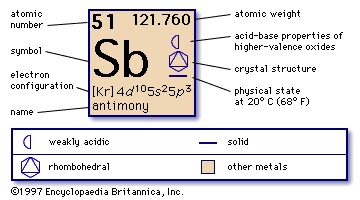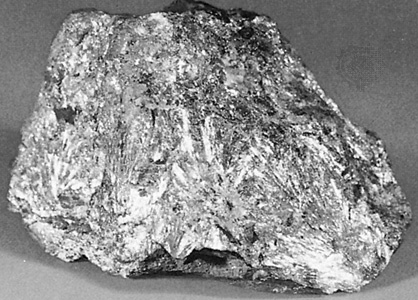antimony
chemical element

 a metallic element belonging to the nitrogen family (Group Va of the periodic table). Antimony exists in many allotropic forms (physically distinct conditions that result from different arrangements of the same atoms in molecules or crystals).
a metallic element belonging to the nitrogen family (Group Va of the periodic table). Antimony exists in many allotropic forms (physically distinct conditions that result from different arrangements of the same atoms in molecules or crystals). Antimony is a lustrous, silvery, bluish white solid that is very brittle and has a flaky texture. It occurs chiefly as the gray sulfide mineral stibnite (Sb2S3). One method of obtaining antimony from stibnite is by roasting the ore to form the oxide Sb2O3, which is then reduced to the element by heating it with carbon. Another is to melt the ore with scrap iron in a furnace; as the iron combines with the sulfur to form a liquid layer of molten iron sulfide, the heavier liquid antimony settles to the bottom and is drawn off.
Because it is a poor conductor of heat and electricity, antimony tarnishes only slightly in dry air, but it is gradually converted to an oxide if the air is moist. When it is heated in air, it burns with a brilliant blue flame and gives off white fumes of the trioxide Sb2O3. The trioxide of antimony is soluble in either acids or alkalies.
In its pure state antimony has no important uses, but, when combined physically or chemically with other substances, it is an extremely useful metal. Because some antimony alloys expand on solidifying (a rare characteristic that they share with water), they are particularly valuable as castings and type metal; the expansion of the alloy forces the metal to fill the small crevices of casting molds. Moreover, the presence of antimony in type metal, which also includes lead and small amounts of tin, increases the hardness of the type and gives it a sharp definition. Even when added in minor quantities, antimony imparts strength and hardness to other metals, particularly lead (lead processing), with which it forms alloys used in plates of automobile storage batteries, in bullets, and in coverings for cables. Combined with tin and lead, antimony forms antifriction alloys called babbitt metals (babbitt metal) that are used as components of machine bearings.
Antimony compounds (especially the trioxide) are widely used as flame retardants in paints, plastics, rubber, and textiles. Several other antimony compounds are used as paint pigments; tartar emetic (an organic salt of antimony) is used in the textile industry to aid in binding certain dyes to fabrics and in medicine as an expectorant and a nauseant.
atomic number
51
atomic weight
121.75
melting point
630.5 °C (1,166.9 °F)
boiling point
1,380 °C (2,516 °F)
density
6.691 g/cm3 at 20 °C (68 °F)
oxidation states
−3, +3, +5
electron config.
1s22s22p63s23p63d104s24p64d105s25p3
- Carlota
- Carlotta Grisi
- Carlo Vincenzo Ferrero di Roasio, marchese d' Ormea
- Carlo Vincenzo Ferrero di Roasio Ormea, marchese d'
- Carlow
- Carlowitz, Treaty of
- Carlo Zeno
- Carl Perkins
- Carl Peters
- Carl Philipp Emanuel Bach
- Carl Piper, Greve
- Carl Reinecke
- Carl Remigius Fresenius
- Carl Richard Moore
- Carl Ritter
- Carl Rowan
- Carl R. Rogers
- Carl Ruggles
- Carl Sagan
- Carl Sandburg
- Carlsbad
- Carlsbad Caverns National Park
- Carlsbad Decrees
- Carlsberg Ridge
- Carl Schurz